Top facts you shoud know about camels:
Camels are one of the most unique creatures to ever walk the earth. With their graceful strides and long eyelashes, it’s hard not to appreciate them for what they are: beautiful animals with a lot of personalities. Let’s discover top facts about camels.
1. Camels can stay a long time without drinking
It is often said that camels are able to go a week without drinking, and it is true, but they can lose up to 40% of their body weight due to dehydration. There is a well-known case when an animal that did not drink for 8 days lost 100 kilograms of weight, but then in 10 minutes, it drank 103 liters of water, compensating the loss without harming itself.
2. Their droppings can be used
In hot and dry deserts, no one can waste moisture, and camels are perfectly adapted to saving it. Even their droppings come out so dry that they can be used as fuel for a fire, as Bedouins and Arabs have been doing with success for centuries.
3. They can smell very well
They have a keen sense of smell, and their noses are particularly sensitive to changes in the humidity of the air. Due to this feature, they can smell a body of water at a distance of up to fifty to sixty kilometers.
Have you ever done a camel ride? Planning to visit Morocco?
We are a local travel agency in Morocco. Being locals based in the desert of Merzouga, we are specialized in organizing camel rides in Morocco and spending nights at the desert camp. Contact us if you are planning a trip to Morocco and we will ensure your adventure will be memorable.
Check out our tours:
4. Different uses of their urine
Camel urine has traditionally been used in Arab countries to treat a wide variety of ailments, from hair loss to dropsy abdomen. In Yemen, for example, it is still used today, and it can easily cost up to 20 American dollars per liter. The WHO (World Health Organization) has repeatedly stated that using camel urine is deadly.
5. Camels can race
Camel racing is incredibly popular in the UAE, but it is entertainment only for the cosmically rich sheiks. The cost of a thoroughbred racing camel is in the hundreds of thousands of dollars, and each such animal is a source of pride to its owner.
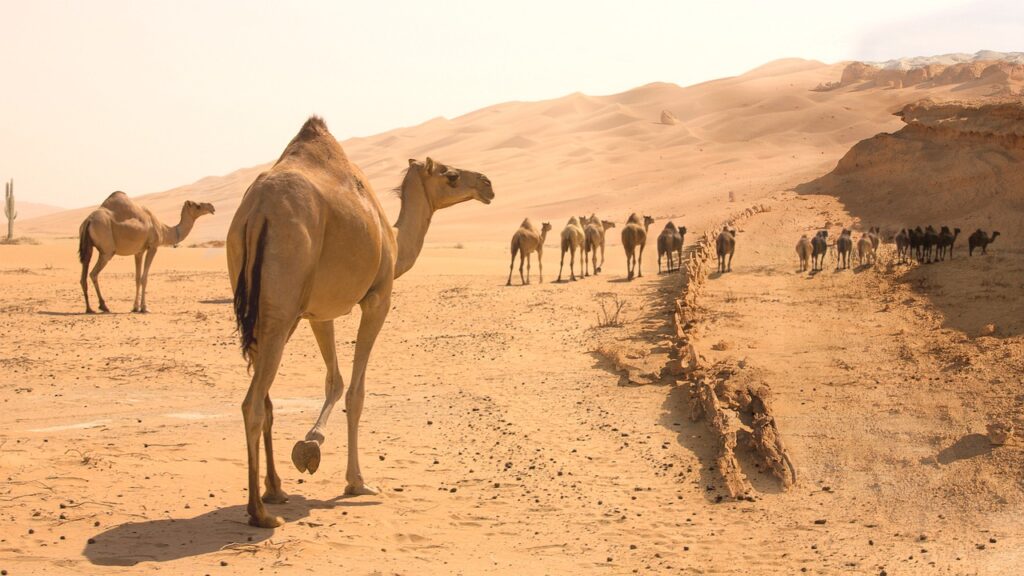
6. Camels can fight
Camel fights have been popular in Turkey for centuries, although nowadays they are only held in rural areas. It is a brutal sport, but it does not result in the death of the animals involved. The fight ends when one of the camels admits defeat by lying down on the ground or trying to escape.
7. Treat them well
You should not tease the camels, because they can easily spit at the annoying person. They spit extremely accurately, and these spits stink just awful because these animals spit not just saliva, but stomach fluids.
8. Camels in the army
In ancient times and in the Middle Ages fighting camels were actively used in the armies of different countries. Most often they were used as transport animals, but Berbers and Arabs, for example, about 3000 years ago, were actively using camel cavalry. Each animal usually had two warriors on its back, one of which was armed with a spear and the other with a bow and arrow.
9. Camels can run quite fast
Unlike horses, camels are not able to remove excess heat, so when they overheat while running, they only increase their body temperature by a few degrees. But such overheating has an effect on them, so they are not able to run for a long time at high speed. However, at short distances, camels are able to reach a speed of up to 65 km/h.
10. Mails through camels
In the past, camel mail was popular in Central Asia, Australia, and Africa. It was actively used even in the Soviet Union, and even relatively recently, about a hundred years ago. Then it was superseded by automobiles and motorcycles, but in some remote parts of Asia, it is still in use.
11. The origin of the name
There is a common myth on the net that the word “camel” in Arabic means “beauty”. This is not true: it comes from the Gothic language, and the Goths, in turn, borrowed it from the ancient Indians, and the original word meant “elephant”.
12. They store fat in the humps not water
Another myth claims that these animals store accumulated water in their humps. This is not true-the camels’ humps store fat reserves that serve two purposes. First, it’s a store of nutrients and moisture, and second, the fat helps them regulate their body temperature.
13. Their lips don’t get hurt
The rough skin on camels’ lips is a prime example of modification variability. There is almost no vegetation in the desert, and the easiest thing to find here is a camel’s thorn. In the course of evolutionary processes, the lips of these animals have coarsened enough to eat these thorny plants without fear of injury.
14. You should try their milk!
In the desert and arid countries, camel’s milk is a popular food item. It is very nutritious and contains almost all substances necessary for normal vital functions of the body. A person, eating only it, could live for about a month.
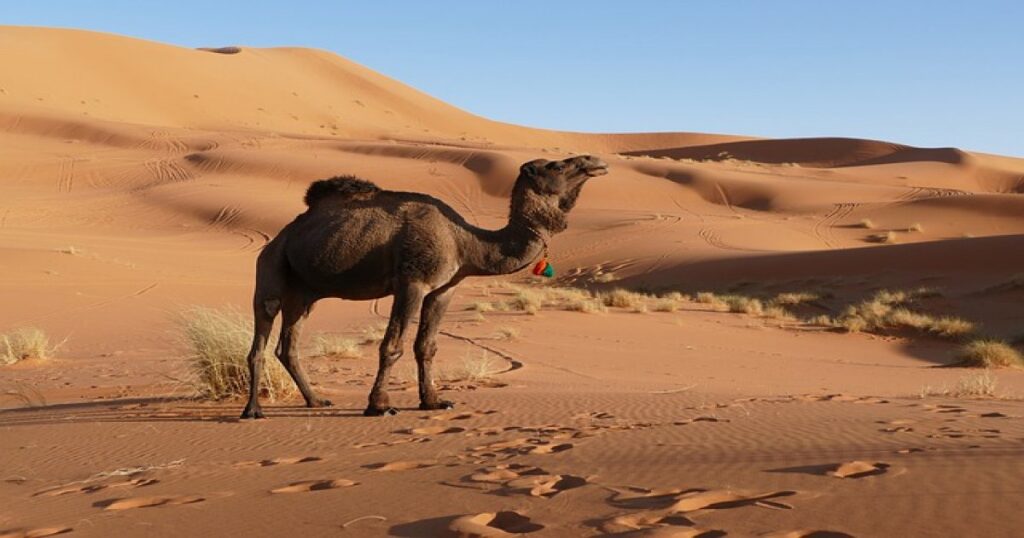
15. There are two types of camels
Camels can be two-humped (Bactrians) and one-humped (Dromeders). In the relatively recent past, huge herds of wild dromedaries were found in many regions, but only their domestic, as well as repeatedly feral congeners, have survived to this day.
16. Australia, the homeland of dromedaries
The largest population of feral dromedary camels in the world lives, oddly enough, in Australia. During the second half of the XIX century, many of these animals were brought to this continent, and now the number of their “wild” population is estimated at 50-100 thousand individuals.
17. Get to know Camel’s Thorn
Camel’s Thorn is an incredibly hardy plant, capable of growing in the driest desert. Its roots can go 15-20 meters underground to reach underground water sources. Interesting fact: In botanical terms, Camelina’s relatives are beans, peas, and other legumes.
18. How long is camel pregnancy?
Pregnancy in camels lasts longer than in the vast majority of living creatures on Earth, usually from one year to one year and three months. Although elephants, for example, have gestation periods of up to 22 months.
19. Are there any wild camels?
Currently, there are only a few hundred wild two-humped camels left in the wild, and scientists doubt that they will manage to survive. Humans domesticated these animals long ago, but their wild relatives were gradually forced out of the territories they occupied, putting them on the brink of extinction.
20. How much can they carry?
These animals are incredibly hardy. Adults are able to even in unbearable heat to carry a cargo of 250-300 kg, which is only slightly under half their own weight, and thus overcome 30-40 km every day. If a camel is carrying only a rider, it can easily cover up to 100 km a day, pacing at an average speed of 10-12 km.
21. Where are most camels situated?
Contrary to popular belief, there are far more camels in Africa than in the Middle East, although they do exist. There are about 14.5 million camels on the African continent, and there are about 19 million camels in the world.
22. Camels have rough pads
Camels have leathery pads on their feet similar to those found on the feet of cats and dogs. But camels have very thick and rough pads that protect them from injuries and hot sand at the same time.
23. How hot their bodies can get?
The body temperature of these amazing animals directly depends on the time of day, or rather, on their activity and on the temperature of the environment. During the hot daytime their temperature rises up to 40.5 ° C, and at night when the “ship of the desert” is sleeping it may go down to 34-35 ° C. There is a reason for this: their body temperature rises in the daytime so that the animal is not hot, and so it does not sweat, thus losing precious moisture.
24. Can they live for so long?
In the wild, camels can easily live up to 40-50 years, as they rarely fall prey to predators. In captivity and with proper care, they can live even longer, if, of course, the owners take care of them, feed them well, and do not exhaust them with constant hard labor.
25. They interbreed with llamas
One-humped camels can interbreed with llamas, animals that are only found in the wild in South America. This interbreeding is only possible through artificial insemination, and it results in the birth of camels, which are hybrids of these two species. However, they both belong to the camel family.
26. Camels and dromedaries are equal in size
Adult individuals of two-humped and one-humped camels are approximately equal in size. It is interesting that the newborn babies of these species are very different – a two-humped newborn usually weighs about 60 kilos and a one-humped one can easily weigh up to 100 kilos.
27. Jews don’t like eating camels or drinking their milk
Although many people in Africa and the Middle East eat camel milk and meat, the Jews never did. In Judaism, the camel is considered an unclean animal, so it is forbidden to eat it.
28. Camels can survive sandstorms
These amazing animals are not afraid even of strong sandstorms, which sometimes occur in the desert. To wait them out, they just lie down on the sand or, ideally, try to hide somewhere behind rocks, if there are any nearby. Their eyes are reliably protected from grains of sand by thick eyelashes, much thicker than those of people.
29. Camels are stubborn
Camels are famous for their stubbornness; even experienced herdsmen and herdsmen cannot always find an approach to them. If an animal wants to lie down and sleep, it is almost impossible to make it get up and walk.
30. Their blood cells are oval
This phenomenal ability to tolerate severe dehydration is a consequence of the fact that camels’ red blood cells (red blood cells) are oval, not round like humans. As a result, when they are dehydrated, the blood stays fluid, while with us the platelets collide with each other and the blood thickens. It is the only mammal with oval red blood cells.
31. You can get kicked, be careful
As you know, you shouldn’t approach a horse from behind, as it can kick you with its hoof. Horses, in general, can kick either forward or backward, but camels can do it in all four directions, and with one kick they are quite capable of killing a man.
32. These cute animals are able to control their nostrils
They can control their nostrils in a special way, closing them with a conscious effort and opening them only a little for inhalation and exhalation. This helps them keep the inside of their nostrils free of sand during dust storms.
33. How do they survive
These animals get most of the moisture they need for normal life from the plant food they eat. They also need to drink, but less often than most other land mammals.
34. Are camels valuable?
Camels are very valuable in many countries, as they are one of the few farm animals there. They can replace horses, cows, sheep, and goats all at once, giving milk and meat, wool and skin.
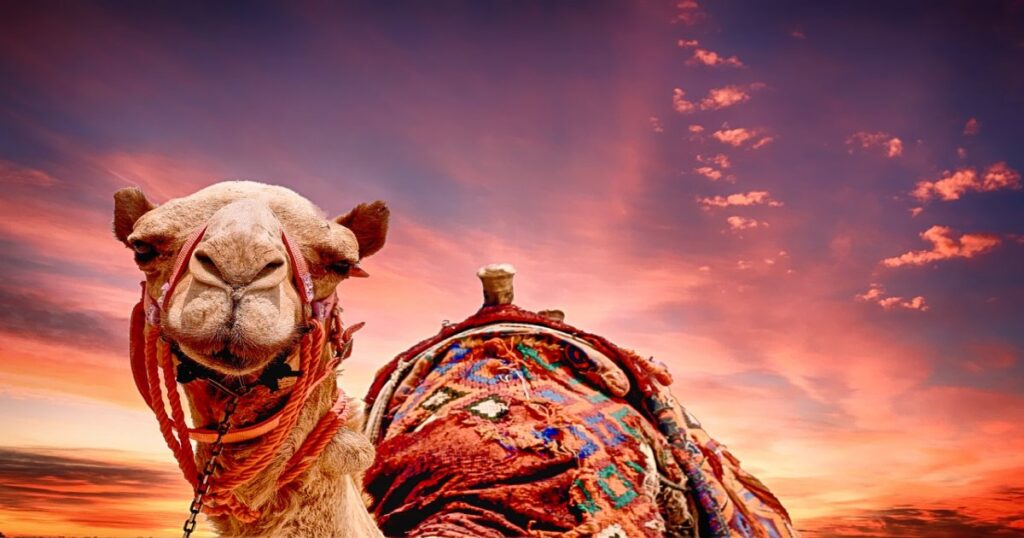
35. Can they really hurt? How?
It is not for nothing that irritated or enraged camels usually spit directly in the face of the source of their irritation. This is their way of blinding and disorienting their opponents so that the spit can be followed by a powerful kick.
36. How Arabians use them?
Arabian people have been using camels as fighting animals for many centuries in spite of the fact that they cannot run for a long time and are easily frightened. Horses just don’t survive in the desert, that’s all.
37. They can drink fast!
Camels are able to drink water faster than any other inhabitants of the Earth. On average, a thirsty animal can drink at a rate of up to 10 liters per minute, or one liter every 6 seconds.
38. Can they stay hungry for a long time?
Their ability to go up to 3-4 weeks without food goes hand in hand with their voracity. When there is enough food, they eat as long as they can fit it in, to stock up. A hungry camel can eat up to 35-40 kilograms of food in one sitting.
39. Can they swim?
Where camels live in the wild, there are almost no bodies of water. In spite of that, they can swim quite well by nature, though most of them have never done it in their lives.
40. What is the difference between 1 humped and 2 humped camels?
One-humped camels live only in warm or hot climates, but their two-humped brethren feel well in cooler climates as well. Curiously, in temperate climates, they grow a luxuriant mane for winter, which thins and shortens again in spring with the advent of warmth.
41. A large group was in the US
In the middle of the XIX century, a large number of Dromaders, one-humped camels, were brought to the United States for the needs of the army. Many of them appeared in the wild later and became feral, but the formed American population died out at the turn of the XIX-XX centuries.
42. Camels seem to have a long history
Ancient people were well acquainted with these animals long ago. Researchers have discovered many rock drawings depicting them, and the oldest of them is estimated to be about 42,000 years old.
43. Camels and robots
In the Arab Emirates, special robot jockeys often act as riders at camel races. They were developed in the mid “zero” years of the XXI century when law forbade to use of them as jockeys were issued – earlier this practice was very common because the less is the weight of the rider, the easier is the camel to run, and this work is very traumatic.
44. When they were domesticated
No one knows exactly when camels were domesticated. Most scientists agree that it happened on the Arabian Peninsula about 4,000-5,000 years ago.
45. Where do they get raced?
Camel racing is popular not only in the United Arab Emirates but also in other countries – Egypt, Pakistan, Qatar, Jordan, Bahrain, and even Australia. Only one-humped dromedaries act as racing animals.
46. How people can help them give birth?
Because of the peculiarities of the uterus structure, female two-humped camels, especially domestic ones, are sometimes unable to give birth to their cubs normally. In this case, people help them, and in order to extract the fetus out, sometimes the power of 3-4 people at the same time is required.
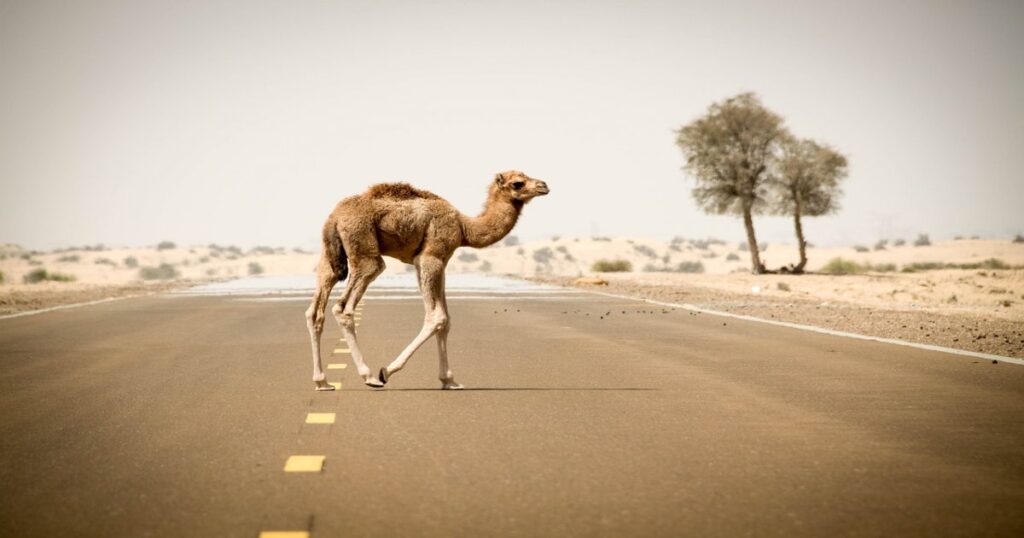
47. Camelids origin
Scientists have established that the first camelids originated in North America. Later they came to Asia by the Bering Isthmus, which at that time had not yet sunk underwater – now in its place is the Bering Strait separating Russia and the USA.
48. Discover Khiml
In the Muslim countries of the East, the standard camel pack, Khiml, has been a common measure of weight for centuries. Depending on the country, the weight of the Khiml varied, but in most cases, it was 250 kilograms.
Articles to read:
- 18 Top Things to Do in Meknes, Morocco
- 20 Top Things To Do In Marrakech
- Ait Ben Haddou Kasbah in Morocco
- Akchour Waterfalls: The Ultimate Guide
- Animals Of The Sahara Desert In Morocco
- Argan Oil in Morocco: All you Need to Know
- Asilah: 10 Best Things to See and Do
- ATV Quad Biking in Merzouga, Morocco
- Backpacking Morocco: Everything You Need to Know for Your Trip
- Beaches In And Near Casablanca
- Beaches In And Near Marrakech
FAQ:
Camels may go without water for up to 15 days. Their humps are one of the reasons they can live for so long. They store fat (not water) in their humps and may utilize this to go longer without water.
Camels can go for extended periods of time without food or water. They can easily carry an additional 200 pounds and trek roughly 20 kilometers each day in tough desert conditions. Camels also supply food (milk and meat) and textiles to people (fiber and felt from hair).
Camels do indeed sleep. They can sleep standing up, which keeps them secure from predators. They sleep for around six hours a night and can survive drastic temperature swings from the blazing heat of the day to the freezing desert nights. Wild camels forage for food at night and rest during the hot summer months.
When camels spit, their cheeks swell and they spew up saliva and stomach contents. It’s intended to catch the camel off guard, divert, or annoy the cause of the camel’s pain.
Yes, They have a high level of intelligence and are quite communicative. They have a complex social structure that communicates via vocalizations and body language. Young camels absorb knowledge like gigantic sponges.

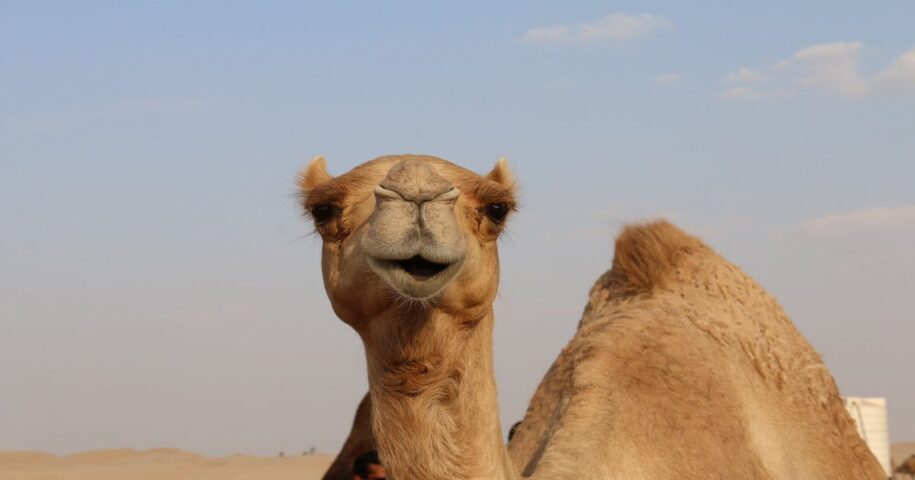
Leave a Reply